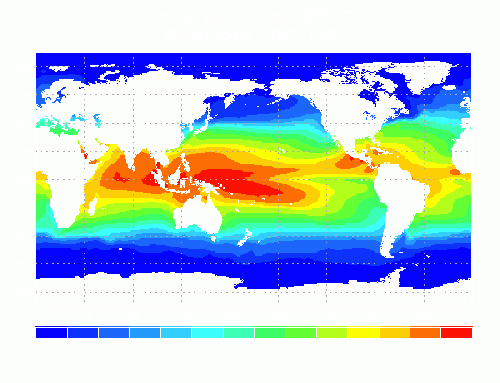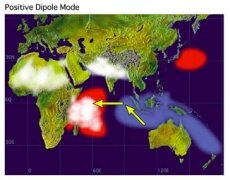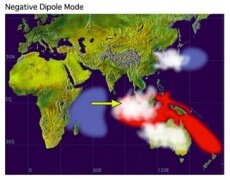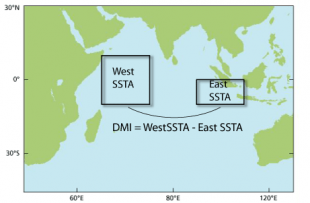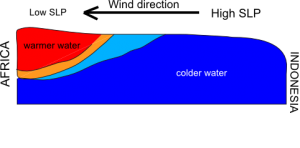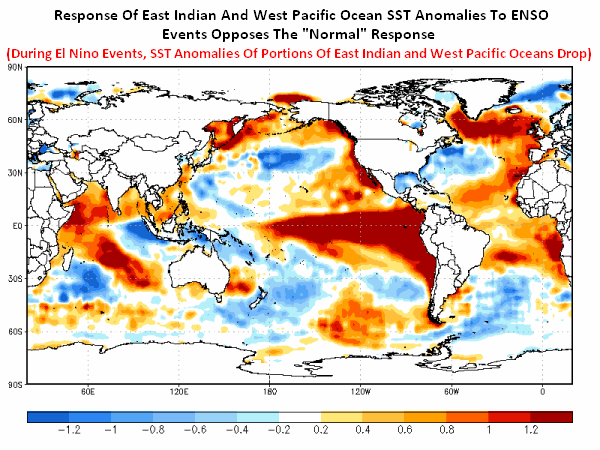From WikiClimateImpacts
|
East Africa
Climate of Equatorial and Tropical East AfricaThe countries of equatorial and tropical East Africa—Ethiopia, Kenya, Somalia, and Tanzania—share a similar annual climate pattern consisting of a winter monsoon from December to March, a “long rains” season that peaks in April and May, a summer monsoon from June to September, and a “short rains” season that peaks in October and November. The rainy seasons that occur during the transitions between the winter and summer monsoons are a result of the migration across the equator of the Intertropical Convergence Zone (ITCZ)—the region where the trade winds originating in the northern hemisphere converge with those originating in the southern hemisphere. The ITCZ occurs along the belt of highest surface temperatures and, thus, migrates twice per year across the equator in response to changes in the sun’s position. The ITCZ migrates toward the north in the northern hemisphere spring (southern hemisphere autumn) and toward the south in the northern hemisphere autumn (southern hemisphere spring). As rainfall is connected to the trade winds system, a shift of the ITCZ corresponds to a shift of the equatorial rainfall belt. The East African long rains season is characterized by heavy rainfall in April and May that is driven by the northward migration of the ITCZ, whereas the heavy rainfall experienced during the short rains season is a result of the migration of the ITCZ to the south. As the southward migration of the ITCZ is more rapid than the northward migration, the period of heavy rainfall is shorter during the short rains season, thereby providing this season with the name short rains. The average daily rainfall during the short rains season is less than during the long rains season, and, compared to the long rains, the short rains exhibit more year-to-year variability, making precipitation forecasts for this season particularly unreliable. Of course, inter-annual variability is not limited to the short rains season. East African precipitation is highly variable across both space and time, and the general seasonal cycle is frequently punctuated by climate extremes ranging from droughts to floods. Excessive rainfall during the short rains of 1997 led to extensive flooding in East and Central Africa, while below-average rainfall during the 2005 short rains season led to disastrous East African droughts in late 2005 and early 2006. Influence of Ocean on East African RainfallIn general, temperature differences between the land and ocean influence regional rainfall patterns through a coupling of oceanic and atmospheric dynamics. Thus, precipitation over equatorial and tropical East Africa is greatly influenced by the sea surface temperature (SST) of the Indian Ocean. Observations indicate that anomalous precipitation events in East Africa frequently correspond to sea surface temperature anomalies (SSTA) in the Indian Ocean. Unusually wet (dry) short rains seasons tend to correspond to colder (warmer)-than-usual SSTs in the tropical eastern Indian Ocean and warmer (colder)-than-usual SSTs in the western half of the Indian Ocean. Changes in the SST structure of the Indian Ocean drive changes in the atmospheric circulation and the normal pattern of convection that controls rainfall in East Africa. Observations suggest that a relationship exists between the East African short rains and the surface winds that blow from the west (termed “surface westerlies”) over the equatorial Indian Ocean. Enhanced rainfall during the East African short rains is associated with weaker westerlies that transport less moisture out of East Africa. The failed short rains of 2005 that resulted in severe drought were associated with a cold SSTA in the northwest equatorial Indian Ocean, a warm SSTA in the southeast equatorial Indian Ocean, and anomalously strong westerly winds. Indian Ocean Sea Surface TemperatureAs can be observed in the figure below by tracing the equator or any tropical line of latitude from west to east across the Indian Ocean, the annual average SST in the eastern Indian Ocean is only slightly warmer than in the western part of the ocean. In general, the waters of the Indian Ocean are warm and, except for the western and eastern boundaries of the basin, the inter-annual variability of the Indian Ocean SST is low. Indian Ocean DipoleIn 1999, Saji et al. described a coupled ocean-atmosphere phenomenon in the Indian Ocean, which they termed the “Indian Ocean Dipole.” Like other coupled ocean-atmosphere phenomena, the Indian Ocean Dipole (IOD) is an inter-annual oscillation with positive and negative phases. During the positive phase of the IOD, the SST decreases in the southeast Indian Ocean and increases in the western equatorial Indian Ocean off the east coast of Africa. The negative phase exhibits the reverse SST structure, with cold SSTAs in the western equatorial Indian Ocean and warm SSTAs in the southeastern Indian Ocean off the coast of Sumatra. The SSTAs that characterize the IOD are coupled to wind anomalies in the central Indian Ocean. As changes in the atmospheric circulation drive changes in East African rainfall, the Indian Ocean partially modulates the inter-annual variability of East African precipitation through IOD events.
Sea surface temperature anomalies during positive (left) and negative (right) Indian Ocean Dipole events. Red indicates warming, blue indicates cooling, white indicates increased convection, and arrows indicate wind direction. The strength of the IOD is measured by the Dipole Mode Index (DMI), which is determined by subtracting the SSTA of the southeastern Indian Ocean from the SSTA of the western Indian Ocean. The DMI varies from -1°C to 1.5°C, with positive values corresponding to the positive phase of the IOD. The IOD, which is also known as the Indian Ocean Zonal Mode, peaks between September and November, the East African short rains season. Positive IOD events correspond to enhanced East African rainfall, and observations indicate that anomalously wet short rains seasons exhibit Indian Ocean SSTAs that resemble the SSTA structure present during IOD events.
A positive IOD is associated with enhanced East African rainfall between September and November (short rains season). In many, but not all cases, a positive IOD is related to El Niño conditions in the Pacific Ocean.
Physical Description of IODThe IOD is partially responsible for the climate variability of East Africa, and recent research has attempted to elucidate the mechanism linking the observed SSTAs with enhanced precipitation during the East African short rains. While observations have linked wind anomalies in the Indian Ocean with enhanced rainfall in East Africa, there is still some uncertainty regarding the degree to which the cold pole (present in the southeastern Indian Ocean during a positive IOD event) contributes to the formation of the anomalous wind conditions. Sea level pressure is lower above warm ocean waters compared to cold ocean waters, so the anomalous SST structure of the Indian Ocean during a positive IOD event may result in an anomalous east-west gradient of sea level pressure with higher sea level pressure over the cold pole in the southeastern Indian Ocean and lower sea level pressure over the warm pole in the western Indian Ocean. As wind blows from high pressure to low pressure, a wind blowing from the east to the west (an “easterly” wind) may develop. Such conditions can contribute to the decrease in strength of the westerly winds, which limits the amount of moisture that is transported out of the East African region, resulting in a wetter short rains season during positive IOD events. In a recent publication, Ummenhofer et al. argue that the warm pole off the coast of East Africa is the predominant driver of the formation of the wind anomalies that force changes in the moisture flux over East Africa. They suggest that large-scale circulation changes result from the decrease in sea level pressure associated with the warm SSTA over the western Indian Ocean and that the cold pole in the southeastern Indian Ocean is much less important in this process. Thus, the wind and moisture anomalies may be a response to the local warm SSTA in the western Indian Ocean rather than to the large-scale SST gradient across the Indian Ocean basin. El Niño-Southern OscillationObservations suggest that a relationship exists between East African precipitation and the El Niño-Southern Oscillation (ENSO), an inter-annual SST oscillation in the tropical Pacific Ocean that is connected to changes in the atmospheric circulation and precipitation over a large portion of the globe. An ENSO warm phase is characterized by warmer-than-average SSTs in the central Indian Ocean. However, the relationship between ENSO and short rains precipitation is not direct. While strong ENSO warm phases correlate to heavy rainfall during the East African short rains (for example, in 1972, 1982, and 1997), some weak ENSO warm phases correlated to anomalously dry short rains seasons (for example, in 1969, 1976, 1986, 1987, and 1991). The influence of the IOD on short rains precipitation is more direct, and it has been suggested that the statistical correlation between East African precipitation and ENSO is actually a manifestation of an association between ENSO and the IOD. ENSO may drive an IOD event through its influence on the Indian Ocean. Roughly one-third of IOD events co-occur with El Niño events, and Black et al. reported a correlation between the IOD DMI and the ENSO Niño3 SST index, which represents the intensity of El Niño events. Thus, the link between ENSO and the IOD, and, thus, ENSO and East African short rains precipitation, is not completely clear.
East African Long Rains PrecipitationWhile precipitation during the East African short rains is correlated with ENSO and the IOD, East African long rains precipitation lacks a direct or strong association with these phenomena. Observations over the last 30 years have shown decreased March through June precipitation over tropical East Africa. The reduction in long rains precipitation is associated with increased SSTs in the western and central Indian Ocean, and these Indian Ocean SSTs have been on an upward trend over the last several decades. ReferencesBehera, S.K., Luo, J-J, Masson, S., Delecluse, Pl, Gualdi, S., Navarra, A. & Yamagata, T. Paramount Impact of the Indian Ocean Dipole on the East Africa Short Rains: A CGCM Study. Journal of Climate. 18, 4514-4530 (2005). Black, E. The relationship between Indian Ocean sea-surface temperature and East African rainfall. Philosophical Transactions of the Royal Society A. 363, 43-47 (2005). Black, E., Slingo, J. & Sperber, K.R. An Observational Study of the Relationship between Excessively Strong Short Rains in Coastal East Africa and Indian Ocean SST. Monthly Weather Review. 131, 74-94 (2003). Marchant, R., Mumbi, C., Behera, S. & Yamagata, T. The Indian Ocean dipole – the unsung driver of climatic variability in East Africa. African Journal of Ecology. 45, 4-16 (2006). Saji, N.H., Goswami, B.N., Vinayachandran, P.N. & Yamagata, T. A dipole mode in the tropical Indian Ocean. Nature. 401, 360-363 (1999). Ummenhofer, C.C., Gupta, A.S. & England, M.H. Contributions of Indian Ocean Sea Surface Temperatures to Enhanced East African Rainfall. Journal of Climate. 22, 993-1013. Williams, A.P. & Funk, C. A westward extension of the warm pool leads to a westward extension of the Walker circulation, drying eastern Africa. Climate Dynamics, published online 04 January 2011. |
|||||||||||||||||||||||||||||||||||



